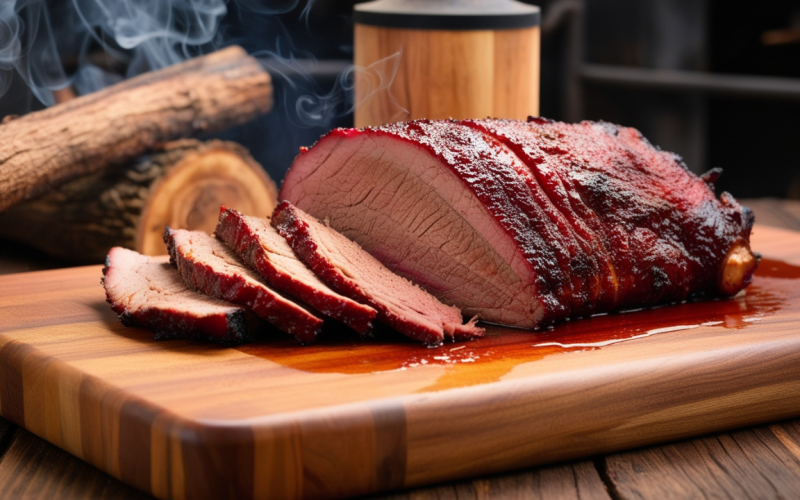How to Make Smoked Brisket Tender and Juicy, Smoking brisket has become a celebrated tradition in American barbecue, especially for those who enjoy rich, smoky Texas-style BBQ. Achieving the perfect balance of tenderness, juiciness, and smoky flavor requires a thoughtful approach to preparation, seasoning, and cooking. In this guide, we’ll explore everything you need to know to make a smoked brisket that melts in your mouth, from choosing the right cut to mastering the art of slow smoking.
Key Takeaways
- Proper preparation and trimming ensure even cooking and enhance flavour.
- Low-and-slow smoking at a steady temperature of 225°F is essential for tender and juicy brisket.
- Wrapping the brisket during cooking helps to retain moisture and intensify flavours.
- Monitoring internal temperature is crucial to achieving the perfect doneness.
- Letting the brisket rest after cooking makes each slice more tender and flavorful.
Understanding Brisket: The Basics
What is Brisket?
Brisket is a cut of beef from the lower chest or breast area of the cow. Known for its dense muscle fibers, this cut requires a slow cooking method to break down the connective tissues, resulting in a tender, melt-in-your-mouth texture. Because it is a tougher cut, brisket benefits greatly from the low-and-slow approach of smoking, which allows time for the meat to absorb flavors and tenderize.
Different Cuts of Brisket
There are two primary sections within a whole brisket: the flat cut and the point cut. The flat cut is leaner and has a uniform shape, making it easy to slice. It’s often preferred for its appearance and texture, particularly for serving as slices.
The point cut, on the other hand, has more marbling and fat, giving it a richer and juicier taste. This section is often used to make burnt ends, which are small, flavorful pieces prized in barbecue.
Choosing the Best Brisket for Smoking
When choosing a brisket for smoking, look for a “whole packer brisket,” which includes both the flat and point cuts. This type of brisket offers a balanced blend of lean and marbled meat, resulting in both texture and flavor.
Look for a brisket with good marbling, as the intramuscular fat will melt during cooking, adding moisture and flavor. Additionally, a brisket that feels flexible and has a slight bend when lifted is a good indicator of tenderness.
Preparing the Brisket for Smoking
Trimming the Brisket for Optimal Results
Proper trimming is a critical step that ensures even cooking and maximizes flavor. To begin, trim the top layer of fat down to about ¼ inch. This layer will render as the brisket smokes, helping to keep the meat moist without preventing smoke penetration.
When trimming, create a uniform shape for the brisket by removing excess fat along the sides and any uneven areas. If there is a silver skin (a tough membrane) on the surface, remove it carefully to prevent chewiness in the final product.
One common mistake in trimming is removing too much fat, which can lead to a dry brisket, as there won’t be enough fat to protect the meat from direct heat. On the other hand, leaving too much fat can prevent the smoke from penetrating the meat, resulting in a less flavorful brisket.
Seasoning the Brisket: Essential Ingredients
A simple seasoning enhances the natural beef flavor while allowing the smoke to add depth. Traditional Texas-style brisket is often seasoned with just salt and black pepper. This minimalist approach creates a flavorful bark, or crust, that complements the brisket’s smoky taste. If you want additional flavor, you can add garlic powder, onion powder, or paprika to your seasoning mix.
Before placing the brisket on the smoker, let the seasoning sit on the meat at room temperature for 30-60 minutes. This resting period allows the salt and spices to penetrate the meat’s surface, creating a deeper flavor as it smokes.
| Ingredient | Measurement | Notes |
|---|---|---|
| Salt | 2 tbsp | For a 10-pound brisket |
| Pepper | 2 tbsp | Adjust based on preference |
| Optional Rub Ingredients | 1/4 cup | Garlic powder, paprika, etc. |
Smoking the Brisket: Step-by-Step Guide
Preparing Your Smoker for Brisket
To start, set up your smoker and preheat it to a steady 225°F. This low-and-slow cooking temperature is essential for breaking down the brisket’s connective tissue, yielding a tender and flavorful result. For wood, use hardwoods like oak, hickory, or mesquite for a robust flavor. If you prefer a milder taste, fruitwoods such as apple or cherry work well. Preheating the smoker allows it to stabilize at the desired temperature, ensuring even cooking.
Keeping the smoker temperature consistent is crucial. A reliable thermometer is an invaluable tool for this, as frequent temperature fluctuations can lead to uneven cooking. Additionally, avoid opening the smoker lid too often, as each opening lets out heat and smoke, prolonging the cooking time.
Placing the Brisket Correctly on the Smoker
The way you position the brisket in the smoker affects how evenly it cooks. Placing the brisket with the fat side up allows the fat to render and baste the meat as it cooks, adding flavor and moisture. Alternatively, placing the brisket fat-side down can help shield it from direct heat, which is useful if your smoker tends to run hotter on the bottom.
Position the brisket in the center of the smoker where it can receive even heat and smoke exposure. This placement is especially important for larger briskets, as it ensures consistent cooking throughout the meat.
Smoking Time Based on Brisket Weight
For most briskets, the general rule is to smoke it for about one hour per pound. This timeframe may vary slightly depending on factors like the smoker’s temperature stability and the brisket’s thickness. Below is a quick guide to help you estimate smoking times based on brisket weight:
| Weight (lbs) | Smoking Time (hrs) | Internal Temperature Goal (°F) |
|---|---|---|
| 8 | 8-9 | 195-205 |
| 10 | 10-12 | 195-205 |
| 12 | 12-14 | 195-205 |
Managing Temperature and Smoke for the Best Flavor
Using a Meat Thermometer
A meat thermometer is essential to monitor the brisket’s internal temperature accurately. Insert it into the thickest part of the meat, avoiding any fat pockets, which can lead to inaccurate readings. For a tender brisket, the internal temperature should reach between 195°F and 205°F. The closer you get to 205°F, the more tender the brisket becomes, as this temperature range allows the collagen to break down fully.
Smoke Control Tips
To achieve the perfect smoky flavor without overpowering the brisket, maintain a moderate smoke output. Excessive smoke can create a bitter taste, especially if the smoker is too hot. For the best results, start with one or two pieces of wood, adding more only as needed throughout the cooking process.
Wrapping the Brisket for Moisture and Flavor
The Texas Crutch: Wrapping the Brisket
One popular technique for maintaining moisture in smoked brisket is the “Texas crutch.” When the brisket reaches an internal temperature of around 160°F, wrapping it helps to lock in moisture and can speed up the cooking process by preventing the meat from drying out.
Wrapping is particularly useful if the brisket hits the “stall,” a phase where internal temperature plateaus for several hours.
Two common wrapping materials are aluminum foil and butcher paper. Aluminum foil provides a tighter seal, trapping in moisture and softening the bark, or crust. Butcher paper, on the other hand, allows some air to circulate, preserving the bark’s texture while still retaining moisture.
Returning the Wrapped Brisket to the Smoker
Once wrapped, return the brisket to the smoker and continue cooking until it reaches an internal temperature of 195-205°F. Maintaining a consistent smoker temperature is still important, as rapid changes in heat can impact the brisket’s texture. Avoid opening the smoker once the brisket is wrapped, as this helps retain heat and ensures even cooking.
Resting and Slicing the Brisket
Why Resting is Essential
Allowing the brisket to rest for one to two hours after smoking is essential for achieving optimal tenderness and flavor. Resting gives the juices a chance to redistribute throughout the meat, making each slice moist and flavorful. Wrap the brisket in foil or butcher paper, and place it in a cooler to keep it warm while it rests. This step enhances the texture and ensures that each bite is tender.
How to Slice the Brisket Against the Grain
To make the brisket easy to chew, it’s important to slice against the grain. The grain refers to the direction of the muscle fibers. By cutting perpendicular to these fibers, you create shorter muscle strands that result in a tender bite. Start by slicing the flat cut, moving toward the point cut as you go. If the point cut appears more marbled, separate it from the flat cut and slice it independently to achieve even pieces.
Key Tips for the Best Smoked Brisket
Maintaining a balance between fat trimming, temperature control, and moisture management is crucial for a tender brisket. Trimming fat layers to an even thickness ensures that the brisket cooks evenly and absorbs smoke flavors without drying out. Monitoring temperature closely helps prevent overcooking or undercooking, and adding moisture during smoking keeps the meat juicy.
Common Mistakes to Avoid When Smoking Brisket
Over-trimming or under-trimming fat can cause issues with the cooking process. Excessive fat can block smoke absorption, while insufficient fat may lead to dryness. Additionally, failing to monitor temperature regularly can lead to uneven cooking, impacting the brisket’s texture and flavor. Slicing with the grain instead of against it can result in a chewy texture, as the muscle fibers remain long and intact.
Serving and Storing Smoked Brisket
Serving Suggestions and Side Pairings
Classic barbecue side dishes such as potato salad, coleslaw, and baked beans complement smoked brisket well. A light BBQ sauce can enhance the flavor without overpowering the brisket’s smoky taste.
| Side Dish | Description |
|---|---|
| Potato Salad | Creamy, pairs well with BBQ |
| Coleslaw | Adds crunch and freshness |
| BBQ Sauce | Sweet and tangy options |
Storing and Reheating Leftovers
To store leftover brisket, place it in an airtight container and refrigerate. When reheating, wrap the brisket in foil and warm it in the oven at a low temperature to retain moisture.
Best Methods to Reheat Without Losing Moisture
Set the oven to a low temperature of around 250°F, and wrap the brisket in foil before reheating for 20-30 minutes. This technique preserves the juiciness and tenderness, ensuring that the brisket remains flavorful even after storage.
Frequently Asked Questions About Smoking Brisket
What Type of Wood Works Best for Smoking Brisket?
Oak and hickory provide a robust, smoky flavor that pairs well with brisket, while fruitwoods like apple or cherry offer a milder taste.
How Long Does it Take to Smoke a Brisket?
The cooking time for brisket varies based on weight and smoker temperature. As a general guideline, expect about one hour per pound.
Why is My Brisket Tough?
A tough brisket is often due to undercooking or slicing it incorrectly. Ensure it reaches an internal temperature of at least 195°F, and always slice against the grain for the best texture.
My Opinion
The guide provides a comprehensive approach to smoking brisket, emphasizing both the technical aspects and the art of achieving tender, juicy meat. In my view, mastering smoked brisket requires a balance of patience, attention to detail, and respect for the process.
Techniques like trimming the fat properly, maintaining a consistent smoker temperature, and using a meat thermometer to monitor internal temperature make a significant difference in the final result.
I appreciate the straightforward methods in this guide, especially the inclusion of wrapping (the Texas crutch) and resting the brisket, as these steps often make the difference between a tough brisket and one that melts in your mouth. For anyone new to smoking or looking to improve their BBQ game, this guide serves as a reliable roadmap.





